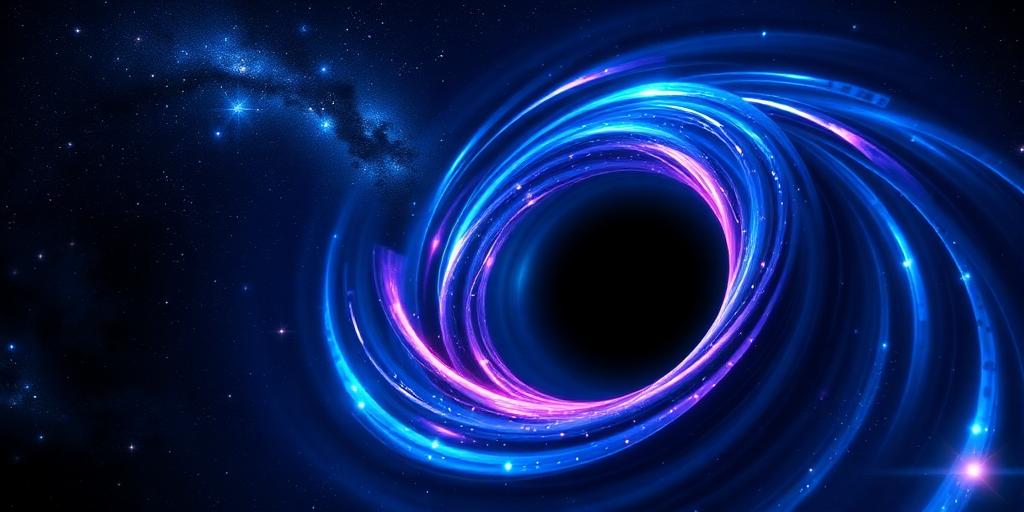Black Holes Explained: A Beginner's Guide to Cosmic Wonders
The universe is filled with phenomena that challenge our understanding, and few are as enigmatic and awe-inspiring as black holes. These cosmic behemoths represent regions in spacetime where gravity is so intense that nothing, not even light, can escape. For those new to the subject, delving into the complexities of black holes can seem daunting. This guide aims to demystify these celestial objects, providing a clear and authoritative introduction to their nature, formation, and impact on the cosmos.
What Exactly is a Black Hole?
At its core, a black hole is not an empty space, but rather a region of extremely compact matter. Imagine taking an object, like our Sun, and compressing it down to the size of a city. The result would be a black hole. This immense compression creates a gravitational field so powerful that it overwhelms all other forces. The defining characteristic of a black hole is its 'event horizon,' a boundary beyond which escape is impossible. Once an object or light crosses this threshold, it is irrevocably pulled towards the center.
How Do Black Holes Form?
The most common way for a black hole to form, particularly the 'stellar-mass' variety, is through the dramatic death of a massive star. When a star with a mass significantly greater than our Sun exhausts its nuclear fuel, its core can no longer withstand the immense inward pressure of its own gravity. The core collapses in on itself, leading to a spectacular supernova explosion that expels the star's outer layers into space. If the remaining core is sufficiently massive (typically more than three times the mass of the Sun), it will continue to collapse, eventually forming a black hole. This process explains how do black holes form in the universe.
Anatomy of a Black Hole
While often depicted as a cosmic vacuum cleaner, a black hole has distinct components:
- The Event Horizon: As previously mentioned, this is the point of no return. It is not a physical surface but rather a boundary in spacetime. Crossing it means you would need to travel faster than the speed of light to escape, which is physically impossible.
- The Singularity: Located at the very center of a black hole, the singularity is a point of infinite density and zero volume. All the mass of the black hole is theorized to be concentrated here. Our current laws of physics break down at this extreme point.
- Accretion Disk: Many black holes are surrounded by an accretion disk, a swirling vortex of gas, dust, and other stellar material. As this matter spirals inward, it heats up to incredible temperatures due to friction, emitting powerful X-rays and other forms of radiation that astronomers can detect.
Types of Black Holes
Astronomers categorize black holes primarily by their mass:
- Stellar-Mass Black Holes: These are the most common, typically 5 to 100 times the mass of our Sun. They form from the collapse of individual massive stars.
- Supermassive Black Holes: Found at the centers of nearly all large galaxies, including our own Milky Way, these giants can range from millions to billions of times the Sun's mass. Their formation mechanism is still an active area of research, but they are crucial to galaxy evolution.
- Intermediate-Mass Black Holes: These are rarer and less understood, falling between stellar-mass and supermassive black holes in size. Their existence is supported by observational evidence but is not yet fully confirmed.
- Primordial Black Holes: A theoretical type, these are hypothesized to have formed in the early universe, shortly after the Big Bang, rather than from stellar collapse.
Understanding these different types of black holes helps us grasp their diverse roles in the cosmos.
The Effects and Observation of Black Holes
Despite their invisible nature, black holes profoundly influence their surroundings. Their immense gravity can warp spacetime, causing phenomena like gravitational lensing, where light from distant objects is bent around the black hole, creating distorted images. They also play a critical role in the evolution of galaxies, influencing star formation and the distribution of matter.
Since we cannot directly observe black holes, astronomers rely on indirect evidence. This includes detecting the X-rays emitted by hot gas in accretion disks, observing the gravitational effects on nearby stars (which appear to orbit an unseen massive object), and most recently, detecting gravitational waves — ripples in spacetime caused by the collision of black holes or neutron stars. These observations provide crucial insights into black hole event horizon dynamics and the extreme physics at play.
Conclusion
Black holes, far from being mere cosmic voids, are fundamental components of our universe. They are extreme laboratories of physics, pushing the boundaries of our understanding of gravity, space, and time. From the stellar remnants of massive stars to the supermassive anchors of galaxies, these objects continue to fascinate scientists and the public alike. As our observational capabilities improve, we uncover more about these mysterious entities, continually refining our knowledge of the cosmos. This beginner's guide to what are black holes has hopefully shed some light on these incredible phenomena, encouraging further exploration into the wonders of astrophysics.









